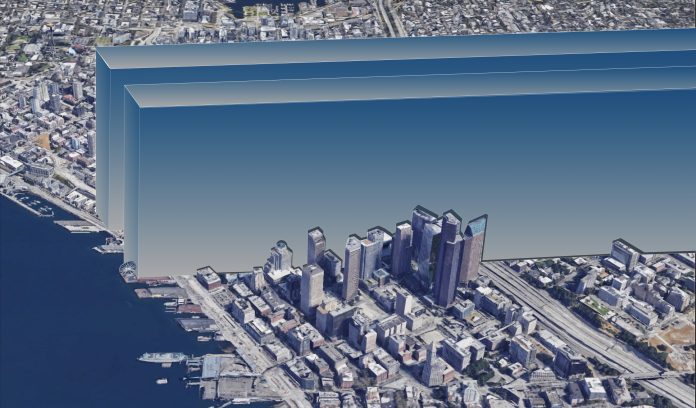
Since we last checked in on the megaproject/arcology beat, there has been some progress on the new NEOM linear city rising from the sands of Saudi Arabia. Contracts have been awarded, new towns have been developed for workers, and excavation continues apace. You can enjoy their most recent promotional video here.
More than just staging and construction moving forward, several other projects have been brought under the NEOM umbrella. NEOM, the project’s name, is the first three letters of the ancient Greek prefix, neo, meaning new. The fourth letter is the abbreviation of an Arabic word, Mostaqbal, meaning future. The additional projects added to NEOM include a new seaport called Oxagon, an island resort called Sindalah, and a mountain ski city called Trojena. They are all complex in size, engineering, and audacity. But because they’re being built on sparsely populated lands far away, they kind of float untethered in space.
Just for fun, and to offer a sense of scale, I thought it would be cool to see what the NEOM projects looked like if they were built in and around Seattle. The projects would cover the region, from Mount Baker to Mount Rainier, and from the Sound to Wenatchee.
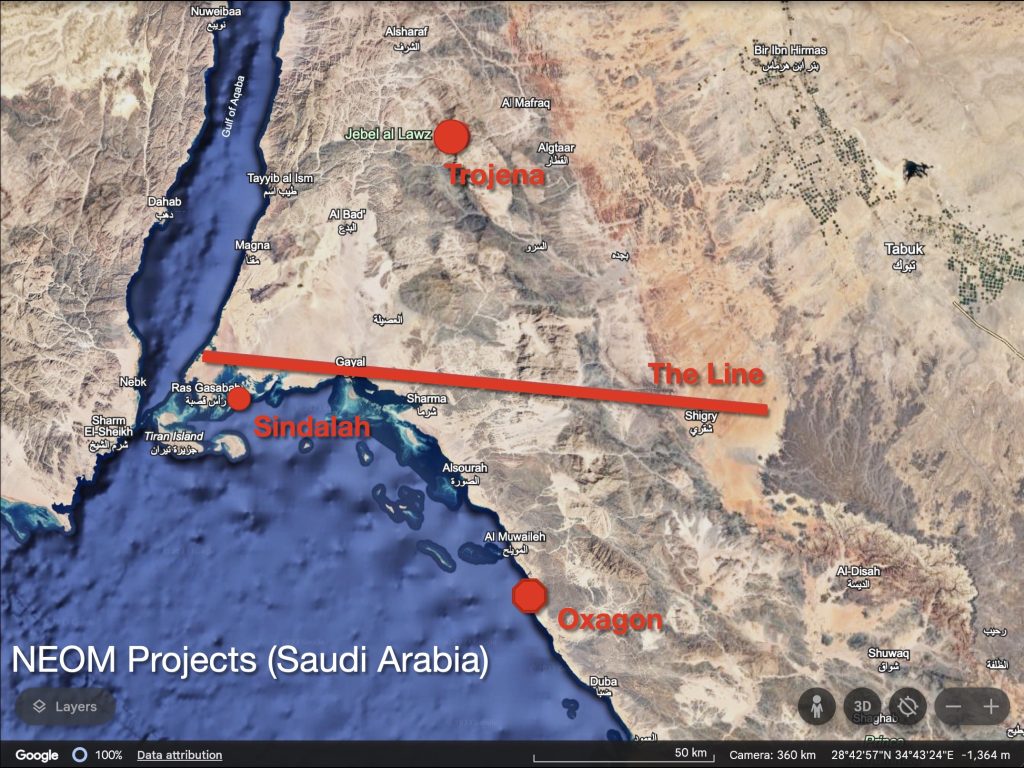
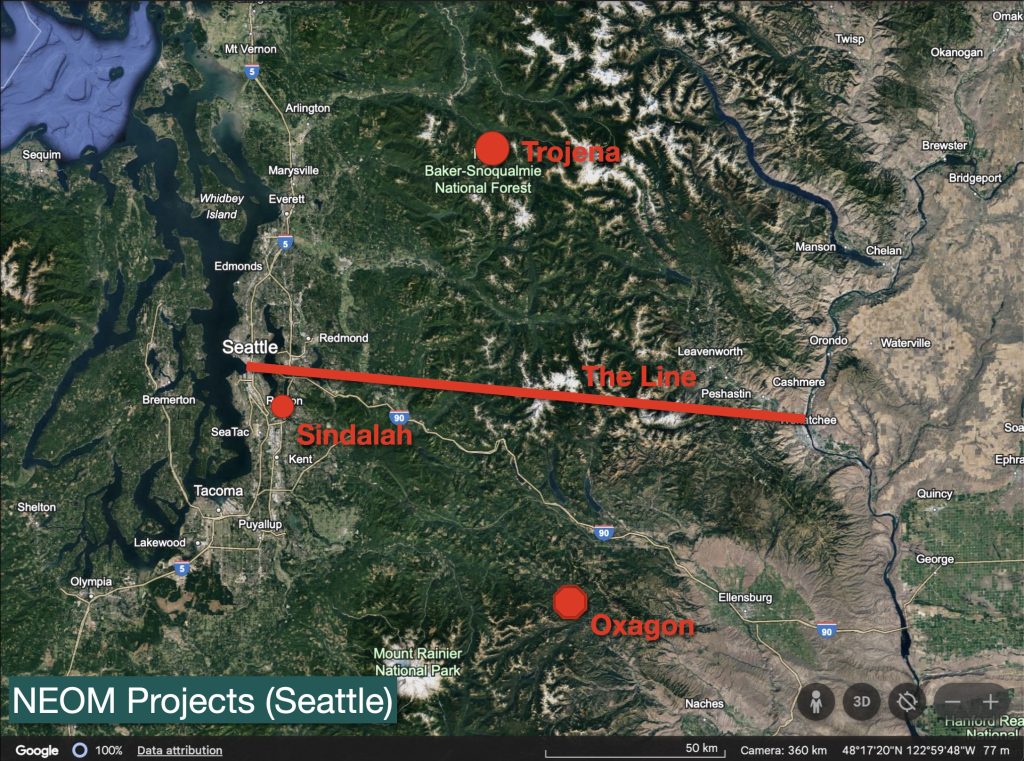
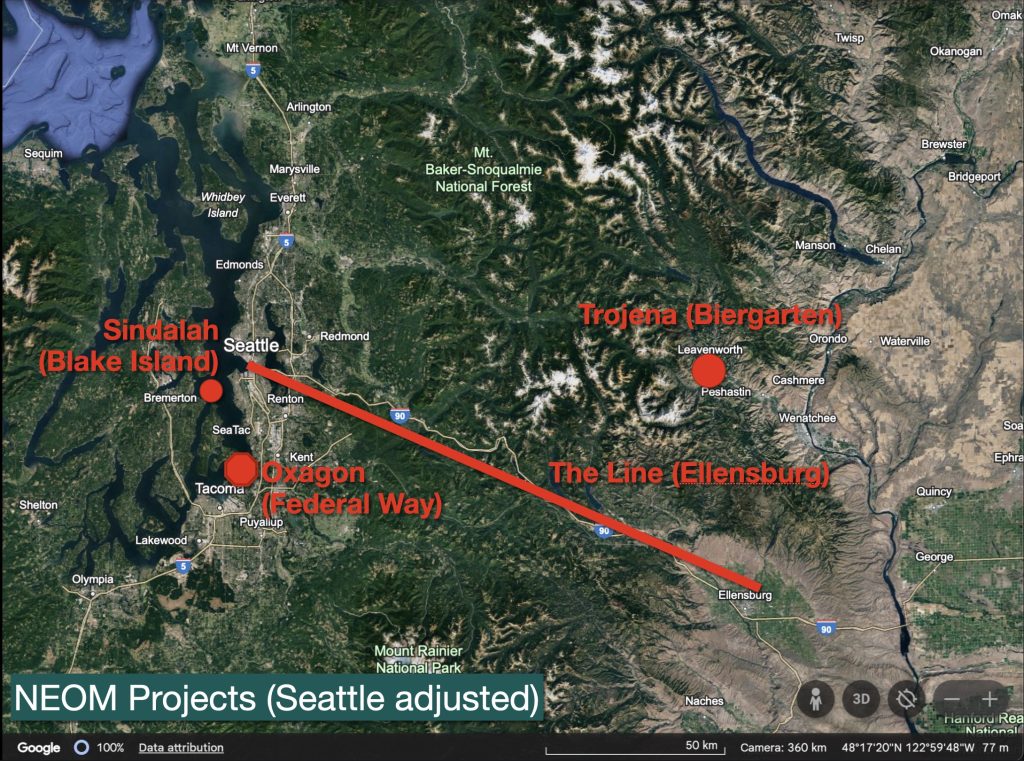
A Seattle Line
The headline project in NEOM is The Line, a complete city packed in a 170-kilometer (106-mile) long superstructure. Renderings show a pair of planks heading into the distance; shiny on the edges and layered, hanging gardens between.
Laying the cornerstone of The Line at the Ferris Wheel on Pier 57 in Seattle, one quickly finds that Seattle is not 170 kilometers wide. So the Seattle Line would continue east across Lake Washington, through Issaquah, and into the mountains. It is a little unclear what the NEOM Line will be doing as it encounters topography, whether it will gently curve upwards or make a noted step. As it is, the length of the building must adjust some 7,000 feet (2,200 meters) to accommodate the curvature of the Earth.

But nothing in its path compares to the 3,000-foot elevation of Snoqualmie Pass. Really, the only comparable place to NEOM on the North American West Coast with a 170-kilometer flat run from the beach inland is the I-10 corridor through Los Angeles. The only others that come close would be some unique curving path through the Columbia River basin or the Golden Gate Bridge area of San Francisco Bay. But The Wiggle doesn’t sound as cool as The Line.
There’s a little discrepancy here, as the press articles for The Line talks about 170-kilometers of length, but the current satellite imagery is clocking in about 156-kilometers, which is the illustration we’re showing on maps in this article. From Seattle, going directly due east for 170 kilometers, the end of the building would be in Waterville, a town of 1,100 in Douglas County. Overlaying the current construction area in Saudi Arabia, the terminus would be Wenatchee. It would probably have a good view into the Gorge. If it were to follow the I-90 corridor, probably the advisable route through Snoqualmie Pass, the east end would be Ellensburg — a megaproject, indeed.
The length isn’t the only massive part of The Line. At 500-meters (1,640-feet) tall, The Line is planned to just about double the height of Seattle’s tallest building, Columbia Center. Currently, there are only 11 buildings in the world that are over 500 meters tall. Of those, the largest footprint belongs to the Makkah Clock Royal Tower in Mecca, Saudi Arabia. Its base is some 1,300 feet (400 m) at its widest part, about 0.002% the length of The Line.
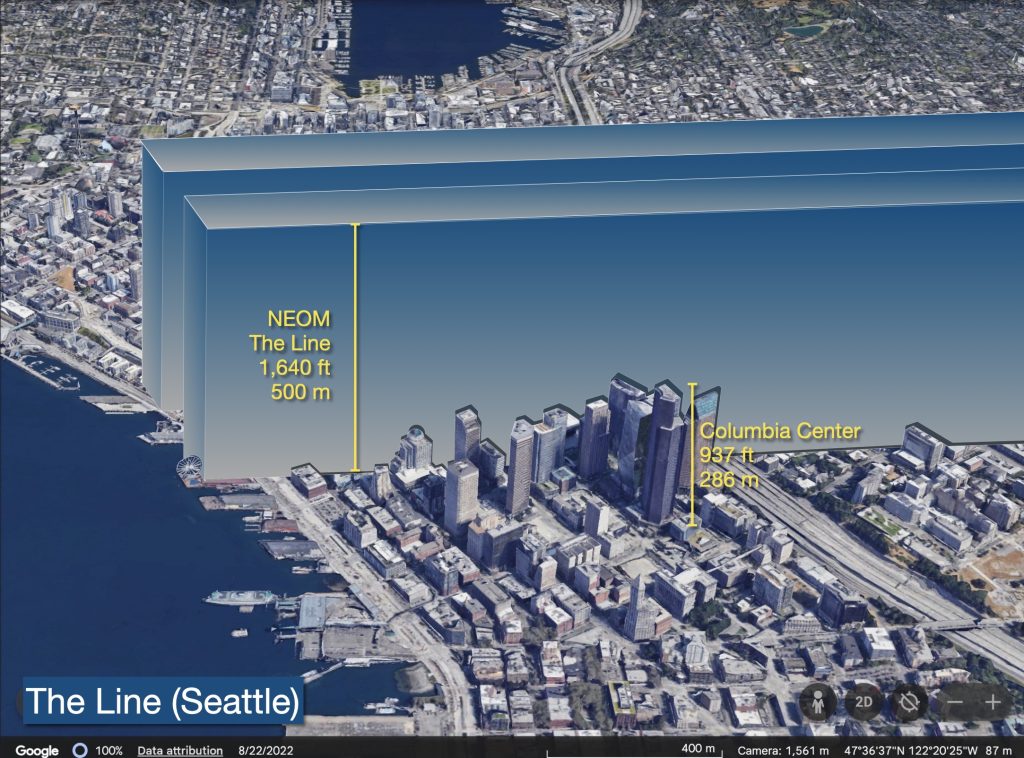
The Line’s base is proposed to be 200-meters (660-feet) across, or three average Seattle downtown blocks. If demolishing a straight path three blocks wide through the city sounds like a lot, it is. It would also be narrower than the footprint for I-5 in South Seattle, at SR 520, and through the U-District.
Now, for those playing along at home, a structure 170,000-meters long, 200-meters wide gives an estimate of 34 million square-meters, or a 34-square-kilometer footprint. Seattle is 217-square kilometers (83.9 square-miles). NEOM predicts it will have 9 million residents. Just the 4.5-kilometer portion of The Line that would run across Seattle could add 238,000 people to the city, pushing us over 1 million residents while using less than 2.5 acres. Seattle is not built out.
Just for further funsies, the world’s current 500-meter buildings run about 100 stories, giving an estimate of 3.4 billion m2 (36 billion square feet) of floorspace in The Line structures. The largest current building by area is the New Century Global Center in Chengdu, China, with 18.9 million square feet (1.7 million m2). The Line will have 2,000 times the built square footage. Amazon has about 13 million square feet (1.2 million m2) of space in Seattle. The Line would be 3,000 times that.
Washington actually has the world’s largest building by volume, Boeing’s assembly plant in Everett, where they built 747s. Its volume of 472 million enclosed cubic feet (13.3 million m3) would be replicated by The Line every football field and a half of its length, and then repeat that over a thousand times.
An Unexpected Ski Resort
Announced without as much worldwide press as The Line, the Saudis are proposing to build a ski resort as part of the NEOM project. Called Trojena, the proposed facility will be the country’s first outdoor ski resort. Much of the press does take pains to say, “Yes, it gets cold enough.” Actual precipitation is a different question, and most of the snow is expected to be manmade. That was enough to convince officials to name the site host of the 2029 Asian Winter Games before ground was broken.
The Trojena project will insert a resort among the otherwise undisturbed Sarawak Mountains, around the peak, Jabal al-Lawz. The mountain itself will be topped with a spire designed by Zaha Hadid Architects. The portal to the resort is referred to as The Vault, a semi-enclosed taco of glass, augmented reality, and hotel rooms as tall as the Space Needle and the width of Lake Union.
At the resort’s center is a mile-and-a-half long artificial body of water that can only be described as an Infinity Lake. It’s just like an infinity pool with a wet edge that melts into the sky, but with jeopardy to real boats.
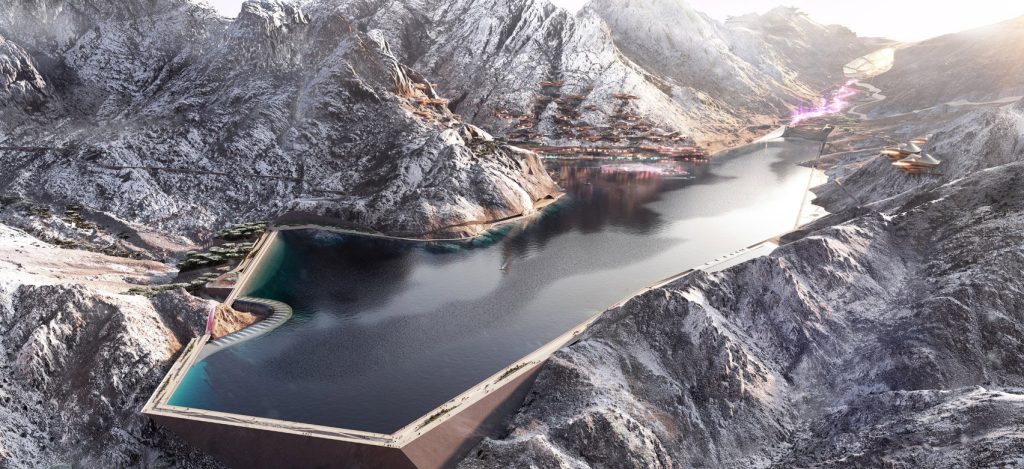

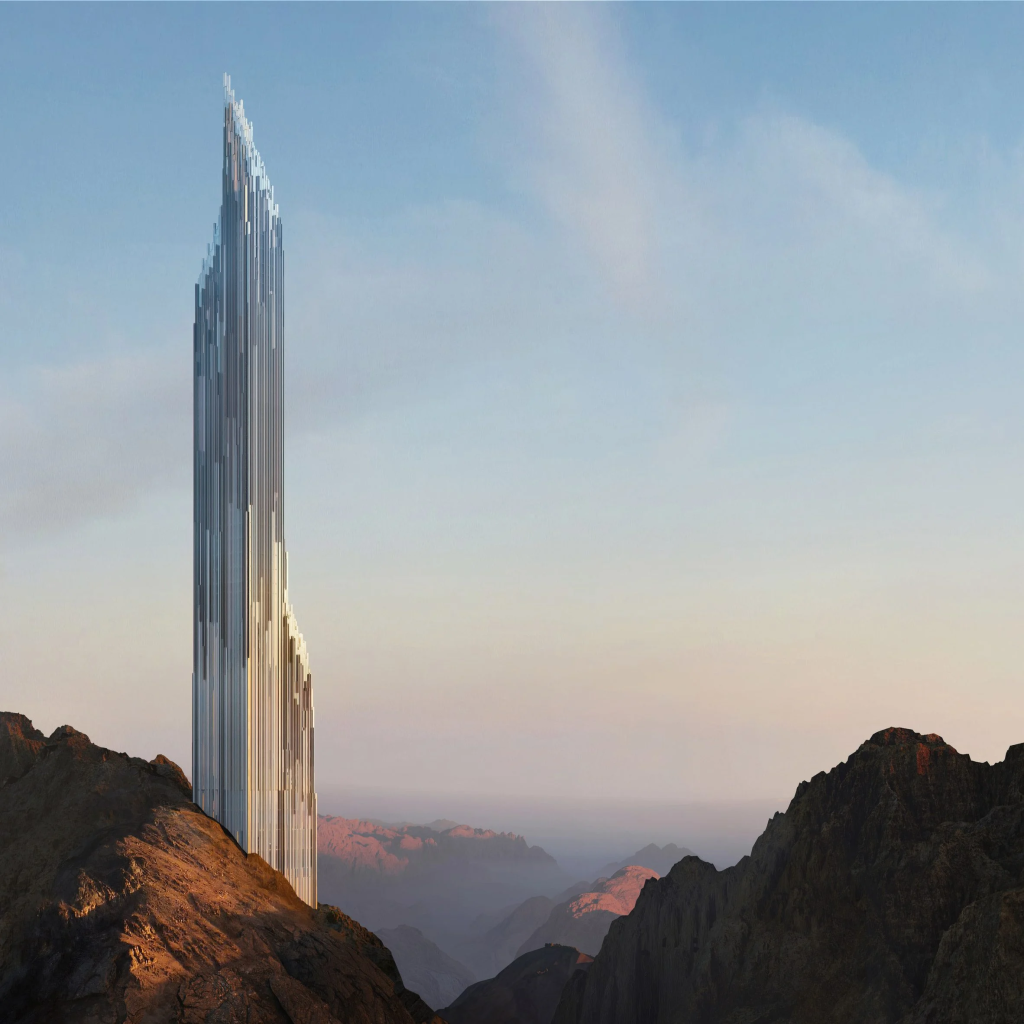
The closest comparable full-service ski resort and alpine sports destination to Seattle would likely be Whistler, BC, having hosted the Winter Olympics. But Whistler also has tons of natural snow, three million visitors per year, and hundreds of trails. A single run at Whistler is about one-third the length of the total ski slopes planned for Trojena.
Trojena sits in relation to The Line approximately the same place that Mount Baker sits to Seattle. At 10,786 feet, Mount Baker is only 1,600 feet taller than Jamal al-Lawz. However, Baker has a much higher prominence, meaning its neighbors aren’t quite as close. The Mount Baker ski resort is 1000 acres, or 1/15th the size of Trojena.
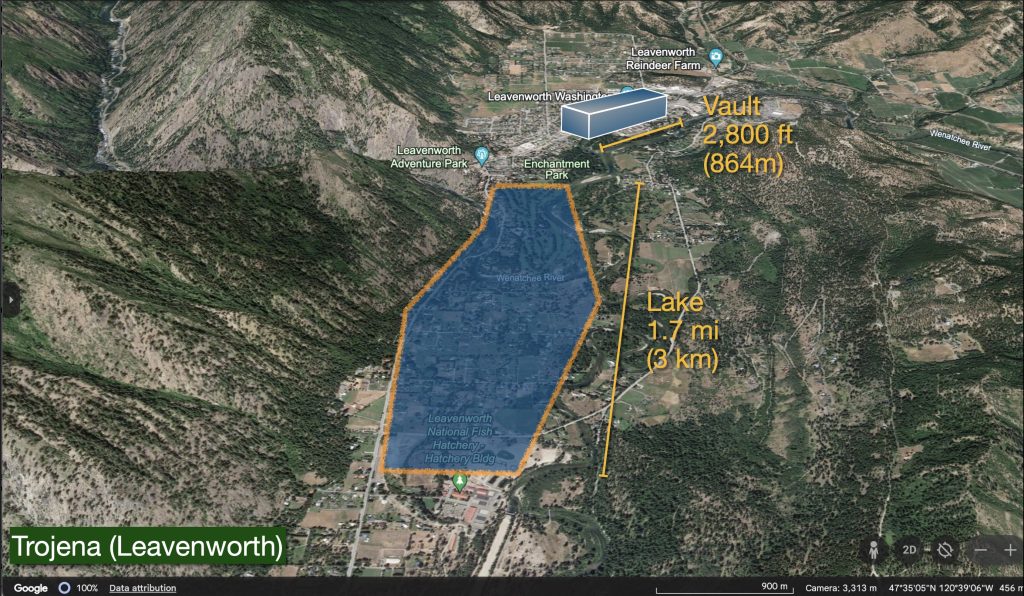
More illustrative may be Washington’s beloved Bavarian town of Leavenworth. The Vault proposed for Trojena is the length of US 2 from Gustav’s to McDonald’s and though the decorated town center. It will be about half the height of the town’s ski hill and host most of the development’s 3,600 hotel rooms. Leavenworth has just over 1,200 rooms. The artificial lake would cover the distance from Leavenworth’s golf course to the fish hatchery. Sadly, there is no indication that the Kingdom will be waiving its strict alcohol policy to compete with Leavenworth’s liter beers, although wine and champagne may be coming to NEOM.
Proportionally, the expected 700,000 Trojena tourists are about a third the number that get up to Leavenworth each year. Those numbers don’t put Trojena in the ranks of the busiest ski resorts in the world, most of which hit 2 million or more visitors. Instead, it’s more in line with exclusive resorts like St. Moritz or Davos, which might be the point. It’s less about specifically skiing and more about showing Saudi Arabia can put a ski resort anywhere it pleases and make it a luxury destination.
Islands In The Sound
Speaking of luxury destinations, there is a new one rising in the Red Sea. Sindalah is going to be the first NEOM project to open. It’s not big, covering just about 200 acres or just less than a third of a square mile. This is comparable to Carkeek Park or half the size of Discovery Park. The site will have 413 rooms in three hotels, which is smaller than the modestly sized Fairmount Olympic Hotel in downtown Seattle. The largest hotel in the city, the Hyatt Regency, has 1,200 rooms.
Tellingly, the Sindalah website touts its 86-berth marina and 75 further offshore buoys for superyachts. Conveniently, it will be just on the other side of the Suez Canal from the very popular yachting in the Mediterranean. Sindalah is going to be a playground for the superrich, in view of The Line megaproject.

Relatively, Sindalah is located near The Line in the same location as Renton is to Seattle. There are zero superyachts that can get into Lake Washington, regardless of the Coast Guard’s position on the matter. And frankly, this level of luxury even exceeds those plebes in hovels on Mercer Island. So it would be a better comparison to look into Puget Sound for a similar island to renovate.
While there are a couple of similarly sized (read: TINY) Puget Sound islands that could be turned into a local Sindalah, many of them like Matia Island, Patos Island and Stretch Island are way to the north or south. The islands closest to Seattle are all fairly large. Whidbey (169 square miles), Vashon (80 square miles) and Bainbridge (65 square miles) are surprisingly expansive.
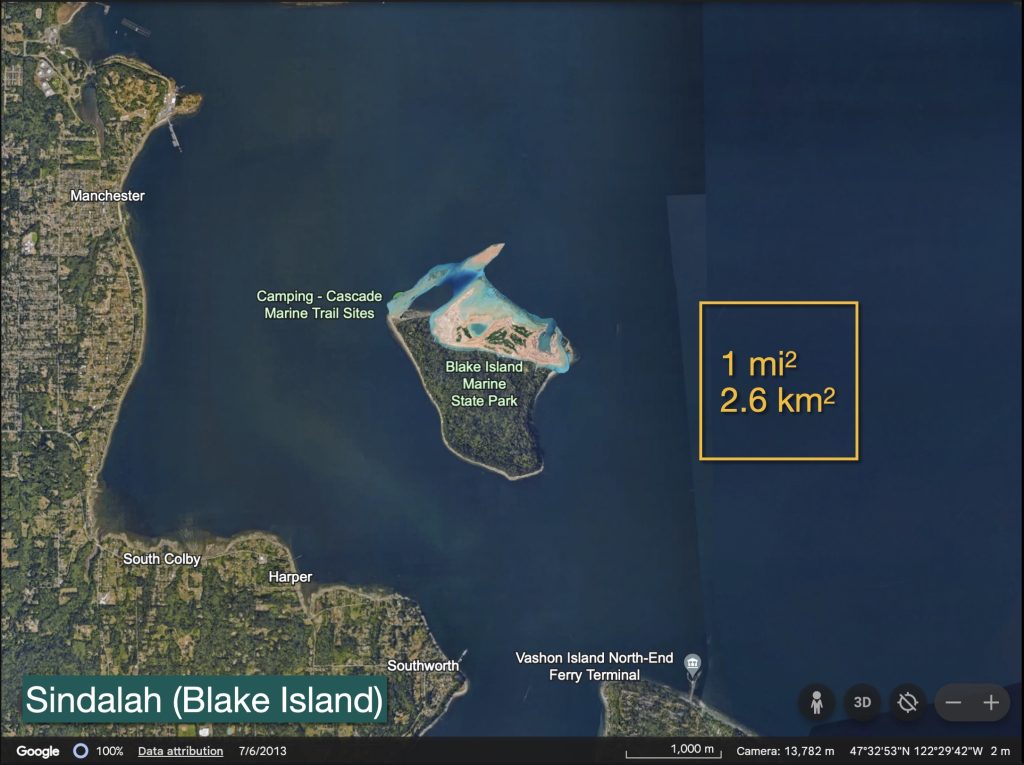
Probably most comparable would be Blake Island, about four times the size of Sindalah but it would work well in that gaze-upon-my-works position across the water from the city. The island is preserved with Blake Island Marine State Park and the only development on it is Tillicum Village. Unfortunately, the concession for dinners and events via tour boats to the village has not been restarted since the pandemic. Washington State Parks suggested they were “just scratching the surface with what could be offered out on the island” in the years before it shut down.
Conversion to a ultra-luxury resort for 2,400 daily visitors may not be the relief to that itch anyone has in mind. It would, however, give superyachts a parking space in the Northwest without interfering with light rail to Ballard.
The Shape of Industry
The last project coming under the NEOM banner is the industrial city of Oxagon. I will admit that this name is bothering me because it is an octagon, but it has an x in it, so I keep drawing it with six sides.
The concept is to expand the Duba seaport south of The Line into a manufacturing and logistics hub. Currently, it serves as a ferry terminal to Egypt. Again, taking advantage of the region’s position on the Red Sea just south of the Suez Canal, Oxagon will offer the chance to intercept ships that don’t have to go up the Gulf of Aqaba to unload onto the continent from the Indian Ocean. The offshore portions are proposed as floating platforms, the world’s largest.
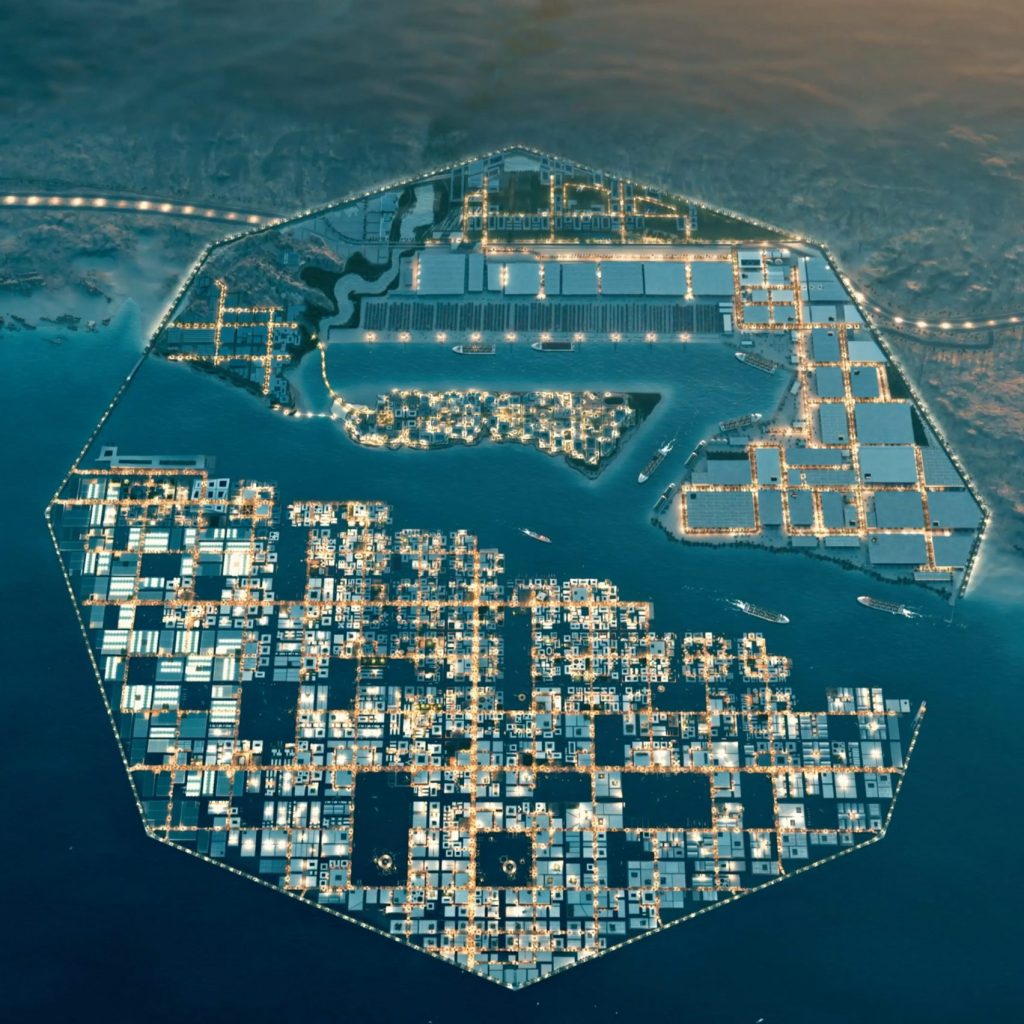
Oxagon is actually pretty far east due to the direction of the Red Sea south of the Sinai Peninsula. If The Line was in Seattle, Oxagon would be just about on top of Mount Rainier, which is not a useful place for a port.
It is difficult to fit a complex the size of Oxagon into Puget Sound. The offshore component extends almost three miles (4.5 km) into the Red Sea. There ain’t that much space in the intricate confines of the Sound south of Seattle. Comparatively, a Puget Sound Oxagon would cover most of Federal Way west of I-5, and fill Puget Sound out to Maury Island. The depths of Puget Sound versus the Red Sea are interestingly similar, though, with both running 500-600 feet at these locations.
It’s also difficult to put a comparison on the 50 km2 (12,000 acres) of industrial space that’s proposed for this Oxagon. The Puget Sound Regional Council identifies 28,615 net acres of industrial lands in its four-county area. That’s space zoned industrial with right of way, parks, protected space and public facilities (SeaTac and other airports mostly) taken out. The Oxagon will have as much acreage as the entire Duwamish Waterway (5,062 acres) and the Port of Tacoma (5,160 acres) combined.
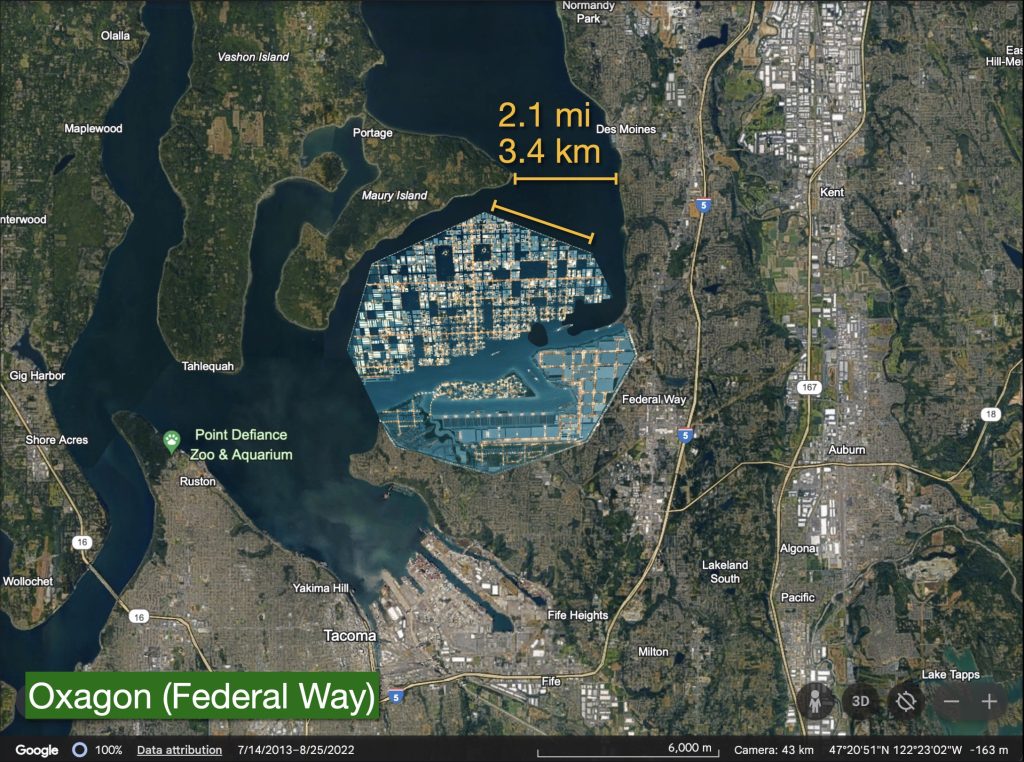
The Messiness of Local Megaprojects
Seattle is not a stranger to megaprojects. In some ways, Seattle itself is a megaproject: a high-promise integrated investment strategy from the start. Sometimes, it has boomed, sometimes busted. We’re a company town, it’s just a question of what company is on top (or imploding) at that moment. We’ve diverted rivers and washed hills to the sea in the name of land speculation and business development.
Then, there are the few times that Seattle’s high-promise got met with high vision, to mixed results. The first was probably the Bogue Plan that integrated transit, parks, and port with a capstone development of a monumental Civic Center just about where the red, twin popsicle sculpture stands on the corner of Blanchard and 4th Avenue today. That failed at the vote. Forty years later, a civic center and gadgetbahn monorail was funded by voters, becoming Seattle Center. That led to votes for Forward Thrust in the late 1960’s. They were split by voters, who approved parks, highways, and a new stadium, but not a subway. Into the 1990’s and voters once again shot down a massive park through South Lake Union called Seattle Commons fearing over-development. See Amazon campus, above.
The newest Big Seattle Plan is Dow’s Folly, a vanity project Civic Center by County Executive Dow Constantine on his way out the door. Multiple downtown buildings to replace the decrepit county offices sounds great, but whether it needs to break the Sound Transit system and planning process is a different question.
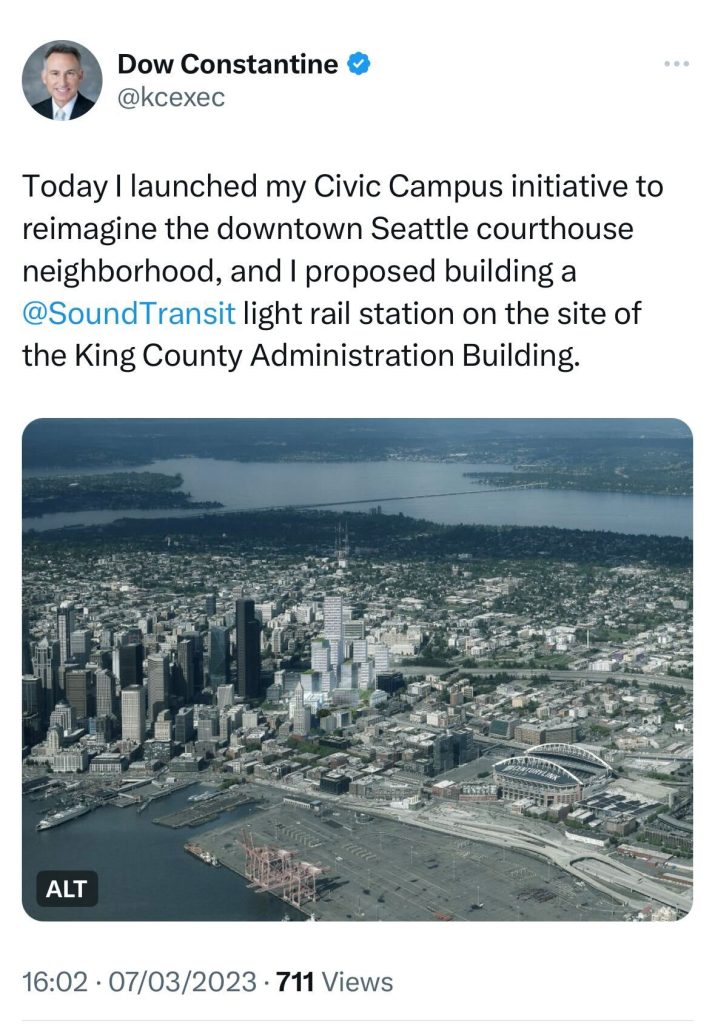
Given the city’s history of voting for or against megaprojects, it’s interesting that the proposal is piggybacking and draining the life out of a transit project that has already been approved by voters, rather than standing on its own. For the record, NEOM projects are on schedule to be completed by 2030, two years before light rail is expected to open in West Seattle, and NINE years before light rail to Ballard.
Of course, that leads to the last comparison. The NEOM projects are not occurring in a democracy. Saudi Arabia is an absolute monarchy, the NEOM projects are headed by highly criticized Crown Prince Mohammed bin Salman, and funded by the oil-enriched sovereign wealth fund. The Kingdom has a long history and extensive present of human rights abuses, several as part of the NEOM projects. A significant part of the NEOM marketing goes to extoll the project’s environmental, social, and governance performance, leaning on high technology but rarely mentioning how people or their opinions fit with the development.
Getting megaprojects underway or completed is not their only hurdle. Arcologies and all utopian visions fall apart because they lean on single visions as much as they lean on monolithic constructions. When that vision is too constraining, the utopia collapses. They’re often touted as the solutions to the messy, fighting, cacophonous places we where live today, which also makes them the antithesis of the creative, boisterous, democratic cities we love.
Ray Dubicki is a stay-at-home dad and parent-on-call for taking care of general school and neighborhood tasks around Ballard. This lets him see how urbanism works (or doesn’t) during the hours most people are locked in their office. He is an attorney and urbanist by training, with soup-to-nuts planning experience from code enforcement to university development to writing zoning ordinances. He enjoys using PowerPoint, but only because it’s no longer a weekly obligation.

